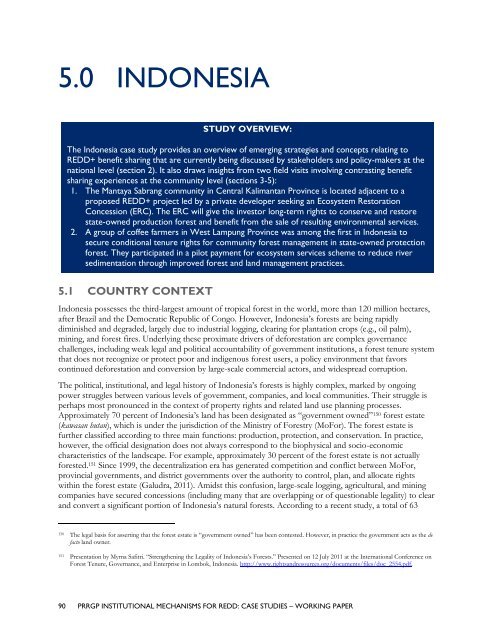Institutional Mechanisms for REDD+ - Case Studies Working Paper
Institutional Mechanisms for REDD+ - Case Studies Working Paper
Institutional Mechanisms for REDD+ - Case Studies Working Paper
Create successful ePaper yourself
Turn your PDF publications into a flip-book with our unique Google optimized e-Paper software.
5.0 INDONESIA<br />
5.1 COUNTRY CONTEXT<br />
STUDY OVERVIEW:<br />
The Indonesia case study provides an overview of emerging strategies and concepts relating to<br />
<strong>REDD+</strong> benefit sharing that are currently being discussed by stakeholders and policy-makers at the<br />
national level (section 2). It also draws insights from two field visits involving contrasting benefit<br />
sharing experiences at the community level (sections 3-5):<br />
1. The Mantaya Sabrang community in Central Kalimantan Province is located adjacent to a<br />
proposed <strong>REDD+</strong> project led by a private developer seeking an Ecosystem Restoration<br />
Concession (ERC). The ERC will give the investor long-term rights to conserve and restore<br />
state-owned production <strong>for</strong>est and benefit from the sale of resulting environmental services.<br />
2. A group of coffee farmers in West Lampung Province was among the first in Indonesia to<br />
secure conditional tenure rights <strong>for</strong> community <strong>for</strong>est management in state-owned protection<br />
<strong>for</strong>est. They participated in a pilot payment <strong>for</strong> ecosystem services scheme to reduce river<br />
sedimentation through improved <strong>for</strong>est and land management practices.<br />
Indonesia possesses the third-largest amount of tropical <strong>for</strong>est in the world, more than 120 million hectares,<br />
after Brazil and the Democratic Republic of Congo. However, Indonesia‘s <strong>for</strong>ests are being rapidly<br />
diminished and degraded, largely due to industrial logging, clearing <strong>for</strong> plantation crops (e.g., oil palm),<br />
mining, and <strong>for</strong>est fires. Underlying these proximate drivers of de<strong>for</strong>estation are complex governance<br />
challenges, including weak legal and political accountability of government institutions, a <strong>for</strong>est tenure system<br />
that does not recognize or protect poor and indigenous <strong>for</strong>est users, a policy environment that favors<br />
continued de<strong>for</strong>estation and conversion by large-scale commercial actors, and widespread corruption.<br />
The political, institutional, and legal history of Indonesia‘s <strong>for</strong>ests is highly complex, marked by ongoing<br />
power struggles between various levels of government, companies, and local communities. Their struggle is<br />
perhaps most pronounced in the context of property rights and related land use planning processes.<br />
Approximately 70 percent of Indonesia‘s land has been designated as ―government owned‖ 150 <strong>for</strong>est estate<br />
(kawasan hutan), which is under the jurisdiction of the Ministry of Forestry (MoFor). The <strong>for</strong>est estate is<br />
further classified according to three main functions: production, protection, and conservation. In practice,<br />
however, the official designation does not always correspond to the biophysical and socio-economic<br />
characteristics of the landscape. For example, approximately 30 percent of the <strong>for</strong>est estate is not actually<br />
<strong>for</strong>ested. 151 Since 1999, the decentralization era has generated competition and conflict between MoFor,<br />
provincial governments, and district governments over the authority to control, plan, and allocate rights<br />
within the <strong>for</strong>est estate (Galudra, 2011). Amidst this confusion, large-scale logging, agricultural, and mining<br />
companies have secured concessions (including many that are overlapping or of questionable legality) to clear<br />
and convert a significant portion of Indonesia‘s natural <strong>for</strong>ests. According to a recent study, a total of 63<br />
150 The legal basis <strong>for</strong> asserting that the <strong>for</strong>est estate is ―government owned‖ has been contested. However, in practice the government acts as the de<br />
facto land owner.<br />
151 Presentation by Myrna Safitri. ―Strengthening the Legality of Indonesia‘s Forests.‖ Presented on 12 July 2011 at the International Conference on<br />
Forest Tenure, Governance, and Enterprise in Lombok, Indonesia. http://www.rightsandresources.org/documents/files/doc_2554.pdf.<br />
90 PRRGP INSTITUTIONAL MECHANISMS FOR REDD: CASE STUDIES – WORKING PAPER

















